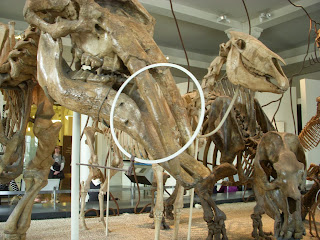Sometimes I can get trip reports up in a reasonable amount of time. Who knew?
Once again the opportunity to visit the AMNH had exposed itself, so of course I was coming along.
The trip proceeded similarly to last time, with Drs. Holtz and Merck giving quick tours on their areas of expertise. It was a bit disconcerting to hear a fellow student identify an ichthyosaur variously as a "fish" and a "dinosaur" even after having heard enough of Dr. Merck's talk to have known better. On the bright side, seeing others genuinely surprised by Dimetrodon being a stem mammal rather than a reptile showed that quality science education is not for naught.
What was different was that this time I didn't get an exclusive tour - not a loss, because I hadn't expected one - and I didn't have to do an assignment, which meant I had much more time to look at and photograph the exhibits. That said, I don't have many pictures to share as I'd hoped. Of relevance is that the glass cases many AMNH specimens are exhibited in are not always conducive to photography, though I think I may have also been having too much fun listening and talking to Drs. Holtz and Merck and Eugenia.
The synapsid halls included some really nice paintings by Jay Matternes that I hadn't seen last time. This is a restoration by him of Paramys.
As a centerpiece, many mounts of hoofed mammals (some closely related, others not) were set alongside each other for comparison. This is good old Toxodon, a member of a clade of South American hoofed mammals whose relationships are still enigmatic.
Up above, a narwhal. Yep, whales are artiodactyls, and thus descended from hoofed animals.
Gomphotherium (a proboscidean afrothere) with a horse (a perissodactyl) and the aforementioned Toxodon in the background.
Remains of pikas (and a hamster) preserved together, probably accumulated by a predator. You can see the fossils better from the front...
The skull of Macrauchenia, another one of those enigmatic extinct South American mammals.
Paleoparadoxia, a desmostylian afrothere.
Metaxytherium, a fossil dugong.
The skull of Moeritherium, a stem elephant.
Suddenly, a Mesozoic reptile. This is Placodus, a placodont. Some have suggested that it led a lifestyle similar to sirenians. I can certainly see some superficial skeletal similarities.
The geology exhibits at the AMNH were really good. This is a demonstration of orogenesis (mountain building) using colored sand.
This display is about the deformation of rocks (as suggested by the sign). On the left is undeformed rock, while those to the right have been exposed to successively higher pressures.
On our way to the human origins hall (which I'd neglected to take pictures of), we passed by a trilobite display sitting out almost in the middle of nowhere. I photographed a few that I thought looked interesting. Here are (from left to right) Walliserops, Dicranurus monstrosus, and Dicranurus hamatus.
This one is Asaphus.
No dinosaur pictures at all? What sorcery is this?
Monday, March 3, 2014
Subscribe to:
Posts (Atom)























